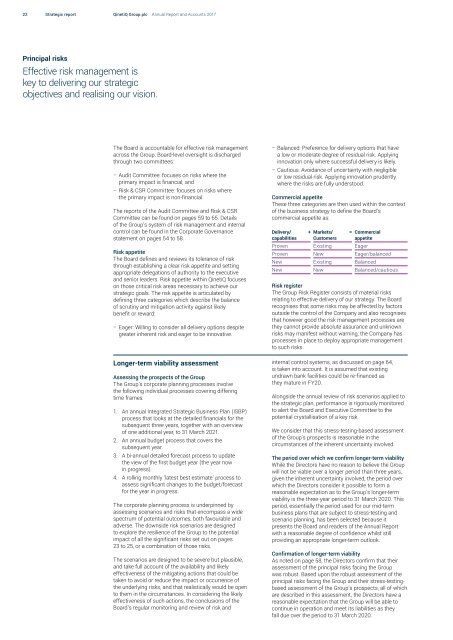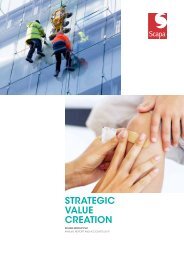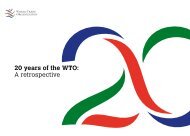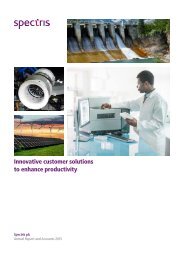QinetiQ Annual Report 2017
You also want an ePaper? Increase the reach of your titles
YUMPU automatically turns print PDFs into web optimized ePapers that Google loves.
22 Strategic report <strong>QinetiQ</strong> Group plc <strong>Annual</strong> <strong>Report</strong> and Accounts <strong>2017</strong><br />
Principal risks<br />
Effective risk management is<br />
key to delivering our strategic<br />
objectives and realising our vision.<br />
The Board is accountable for effective risk management<br />
across the Group. Board-level oversight is discharged<br />
through two committees:<br />
––<br />
Audit Committee: focuses on risks where the<br />
primary impact is financial; and<br />
––<br />
Risk & CSR Committee: focuses on risks where<br />
the primary impact is non-financial.<br />
The reports of the Audit Committee and Risk & CSR<br />
Committee can be found on pages 59 to 65. Details<br />
of the Group’s system of risk management and internal<br />
control can be found in the Corporate Governance<br />
statement on pages 54 to 58.<br />
Risk appetite<br />
The Board defines and reviews its tolerance of risk<br />
through establishing a clear risk appetite and setting<br />
appropriate delegations of authority to the executive<br />
and senior leaders. Risk appetite within <strong>QinetiQ</strong> focuses<br />
on those critical risk areas necessary to achieve our<br />
strategic goals. The risk appetite is articulated by<br />
defining three categories which describe the balance<br />
of scrutiny and mitigation activity against likely<br />
benefit or reward:<br />
––<br />
Eager: Willing to consider all delivery options despite<br />
greater inherent risk and eager to be innovative.<br />
Longer-term viability assessment<br />
Assessing the prospects of the Group<br />
The Group’s corporate planning processes involve<br />
the following individual processes covering differing<br />
time frames:<br />
1. An annual Integrated Strategic Business Plan (ISBP)<br />
process that looks at the detailed financials for the<br />
subsequent three years, together with an overview<br />
of one additional year, to 31 March 2021.<br />
2. An annual budget process that covers the<br />
subsequent year.<br />
3. A bi-annual detailed forecast process to update<br />
the view of the first budget year (the year now<br />
in progress).<br />
4. A rolling monthly ‘latest best estimate’ process to<br />
assess significant changes to the budget/forecast<br />
for the year in progress.<br />
The corporate planning process is underpinned by<br />
assessing scenarios and risks that encompass a wide<br />
spectrum of potential outcomes, both favourable and<br />
adverse. The downside risk scenarios are designed<br />
to explore the resilience of the Group to the potential<br />
impact of all the significant risks set out on pages<br />
23 to 25, or a combination of those risks.<br />
The scenarios are designed to be severe but plausible,<br />
and take full account of the availability and likely<br />
effectiveness of the mitigating actions that could be<br />
taken to avoid or reduce the impact or occurrence of<br />
the underlying risks, and that realistically would be open<br />
to them in the circumstances. In considering the likely<br />
effectiveness of such actions, the conclusions of the<br />
Board’s regular monitoring and review of risk and<br />
––<br />
Balanced: Preference for delivery options that have<br />
a low or moderate degree of residual risk. Applying<br />
innovation only where successful delivery is likely.<br />
––<br />
Cautious: Avoidance of uncertainty with negligible<br />
or low residual risk. Applying innovation prudently<br />
where the risks are fully understood.<br />
Commercial appetite<br />
These three categories are then used within the context<br />
of the business strategy to define the Board’s<br />
commercial appetite as:<br />
Delivery/+<br />
capabilities<br />
Markets/=<br />
Customers<br />
Commercial<br />
appetite<br />
Proven Existing Eager<br />
Proven New Eager/balanced<br />
New Existing Balanced<br />
New New Balanced/cautious<br />
Risk register<br />
The Group Risk Register consists of material risks<br />
relating to effective delivery of our strategy. The Board<br />
recognises that some risks may be affected by factors<br />
outside the control of the Company and also recognises<br />
that however good the risk management processes are<br />
they cannot provide absolute assurance and unknown<br />
risks may manifest without warning; the Company has<br />
processes in place to deploy appropriate management<br />
to such risks.<br />
internal control systems, as discussed on page 64,<br />
is taken into account. It is assumed that existing<br />
undrawn bank facilities could be re-financed as<br />
they mature in FY20.<br />
Alongside the annual review of risk scenarios applied to<br />
the strategic plan, performance is rigorously monitored<br />
to alert the Board and Executive Committee to the<br />
potential crystallisation of a key risk.<br />
We consider that this stress-testing-based assessment<br />
of the Group’s prospects is reasonable in the<br />
circumstances of the inherent uncertainty involved.<br />
The period over which we confirm longer-term viability<br />
While the Directors have no reason to believe the Group<br />
will not be viable over a longer period than three years,<br />
given the inherent uncertainty involved, the period over<br />
which the Directors consider it possible to form a<br />
reasonable expectation as to the Group’s longer-term<br />
viability is the three-year period to 31 March 2020. This<br />
period, essentially the period used for our mid-term<br />
business plans that are subject to stress-testing and<br />
scenario planning, has been selected because it<br />
presents the Board and readers of the <strong>Annual</strong> <strong>Report</strong><br />
with a reasonable degree of confidence whilst still<br />
providing an appropriate longer-term outlook.<br />
Confirmation of longer-term viability<br />
As noted on page 58, the Directors confirm that their<br />
assessment of the principal risks facing the Group<br />
was robust. Based upon the robust assessment of the<br />
principal risks facing the Group and their stress-testingbased<br />
assessment of the Group’s prospects, all of which<br />
are described in this assessment, the Directors have a<br />
reasonable expectation that the Group will be able to<br />
continue in operation and meet its liabilities as they<br />
fall due over the period to 31 March 2020.
















